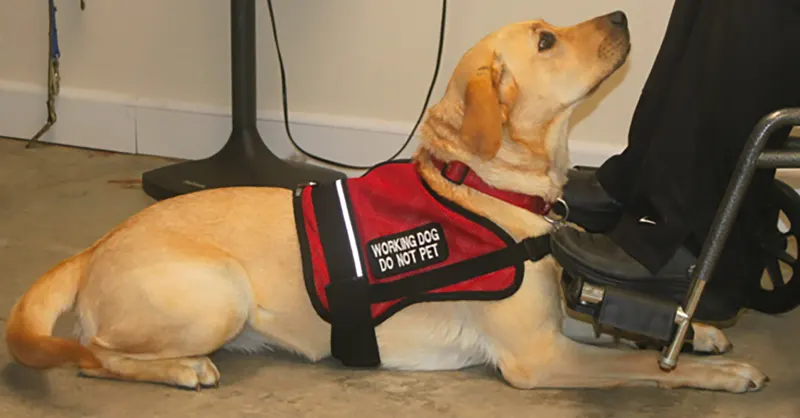Archive for the ‘Therapy Animal’ Category
Humans are lucky to have dogs as our companions. Dogs used to help us watch livestock or help us hunt. Now, they are here to provide us with much-needed support. Unfortunately, people often get assistance animal regulations wrong. We are here to help clear things up. The first step is to understand the rules and regulations around assistance animals.
Can I Register my Dog as a Therapy Dog?There are three types of assistance animals. Each performs a specific function and has special access rights.
Service Animal – trained to perform a specific task for their handler’s disability. Service Dogs have full access to all public places, including restaurants, hotels, and no-pet housing. A fee cannot be a charge for granting access to Service Dogs. A service dog is considered a medical device and not a pet. Emotional Support Animal – does not require special training and provides comfort to their handler. Emotional Support Dogs have access to no-pet housing, and the landlord cannot charge a fee for an ESA as well. Therapy Animal – does not require special training and provides comfort to others. Therapy Dogs do not have special access and must be invited in. A fee can be charged for granting access to a therapy dog.Share this image on your site (copy code below): <div style="clear:both"><a href="https://www.servicedogcertifications.org/how-to-register-a-therapy-dog/" target="_blank"><img decoding="async" style="max-width:100%;margin:0 0 10px;" src="https://www.servicedogcertifications.org/wp-content/uploads/2017/05/service-dog_esa_therapy-dog.jpg" title="3 Types of Assistance Animals" alt="Infographic comparing service dogs, emotional support dogs, and therapy dogs" border="0" data-src="" /></a></div> Copy
You can register your dog as a therapy dog by following the links below!
Therapy Animals are often confused with Emotional Support Animals. A quick way to discover which assistance animal you need is to ask yourself a simple question.
Is my dog here to support my emotional needs or is my dog her to support other’s emotional needs? If the answer is yourself, you require an ESA Letter from a therapist. If your answer is others, your require a Therapy Dog Certification. Train and register your dog as a Therapy Dog in 3 Easy Steps – First – Adopt and train a dog with a calm and kind temperament and can pass a Canine Good Citizen Test. Second – Train your dog to be well-behaved in public places such as a hospital or school. When they go to a hospital or school, they need to be well-behaved as to not hurt others or themselves. Third – Certify your Therapy Dog by registering them with Service Dog Certifications Register your therapy dog hereYour Therapy Dog can also act as your Emotional Support Dog. To qualify your Therapy Dog as your ESA, you will need an ESA letter from a therapist. If your current therapist understands ESA laws and can help you write an ESA letter, this is your best route. If you do not have access to an ESA Doctor or ESA therapist, we recommend seeking support for a legitimate ESA resource.
Therapy dogs are a source of love and affection in our lives and those of our friends and family. They provide a welcome distraction for students during stressful exam periods, give affection and companionship to seniors, and bring comfort to patients recovering from illnesses in hospitals. Therapy dogs can provide people of all ages with unconditional love, a furry hug, and some much-needed stress relief.
Table of contents What is a therapy dog? Types of therapy animals Do I need an emotional support dog or a therapy dog? What is the difference between a service dog and a therapy dog? How do I register my therapy dog? Do I need a special letter for my therapy dog? Dogs are gifted with a multitude of abilities What is a therapy dog?Definition: A therapy dog is a dog that has undergone training to provide comfort and support to people, often in group settings.
Therapy vs. Emotional Support Dogs: Therapy dogs provide help to people other than their owners, while service dogs and emotional support dogs directly assist their owners with a physical or mental health condition. Therapy dogs can frequently be found working in environments such as schools, retirement homes, hospitals, workplaces, disaster sites, nursing homes, and hospices.
There are three basic steps involved in certifying a therapy dog: Adopt a dog with the appropriate demeanor and intelligence to serve as a therapy dog. Train the dog to provide comfort and support to others, including in group settings at various locations. Optionally register your trained therapy dog with an organization, such as Service Dog Certifications.Up next: In this article, we’ll explore how a regular dog can become a therapy dog. We will also explain the key differences between a therapy dog and a service dog or emotional support dog, especially regarding the rights of their handlers.
Types of therapy animalsDifferent animals: Therapy animals are commonly dogs, but they can be any type of domesticated animal that has been trained to provide comfort and support to individuals and groups that are experiencing distress. These animals can provide this service just through their presence – animals are known to have a calming effect on people – but can also be trained to perform tasks. For example, a therapy dog can be trained to lie down to be petted, perform tricks to provide a welcome distraction, or apply comforting paw pressure to someone struggling with anxiety.
Breeds of dog: Any breed of dog can qualify as a therapy dog as long as they have the proper temperament and intelligence. A good therapy dog should have the ability to be around groups of people and remain calm and dedicated to their tasks – they must be able to remain focused even if the individuals around are in distress. Proper socialization for a therapy dog is key because they will come into contact with many strangers and possibly other animals.
Work environments: Therapy dogs often work in various environments, some of which can be chaotic such as a school, hospital, or disaster area. A therapy dog handler has to be able to ensure that their dog will remain alert, calm, and responsive to their commands in any situation. Therapy dogs must also handle surprises, as small children and people suffering from mental health issues may act erratically. Due to the potentially stressful nature of such work environments, it is also important that a therapy dog handler ensures that the dog is not overworked or stressed and is given plenty of breaks and periods of rest.
Even though dogs are traditionally the most commonly used animal in the therapy world, other species can also perform this important work. These include:
Cats – Although they may not be as “transportable” as canines, some nursing homes have made cats a permanent part of their elderly care regimen. A resident feline at a nursing home can weave in and out of the patient’s rooms and, if the mood strikes, may even choose to stay for a snooze or a snuggle. A daily visit from a cat can brighten even the darkest of days. Equine – Horses help individuals dealing with issues like drug abuse, learning disabilities, or rehabilitation. Teaching a person how to trust and interact with a creature, such as a horse, can have invaluable benefits. Small animals – Guinea pigs and rabbits are also being used for therapy work. These small furry animals are easy to manage and can be of great comfort, especially for individuals who may fear dogs or cats. Cats, as well as other small domesticated animals, can make for perfect therapy animals. Do I need an emotional support dog or a therapy dog?The main difference: Therapy dogs provide comfort intermittently, but if you are in need of your own comfort animal at all times, an emotional support animal (ESA) is more appropriate.
ESA rights: ESAs are a recognized type of assistance animal under the Federal Housing Act in addition to various state laws; they are permitted to accompany their owners in residences (even if the building bans pets) free of charge.
ESA types: Emotional support animals are commonly dogs and cats, but they can be any type of small, domesticated animal. ESAs do not require special training – they provide comfort and support for mental health conditions just through companionship.
How to qualify: To qualify for an emotional support animal, you need a letter of recommendation from a licensed healthcare professional. The licensed professional will determine whether you have a condition that qualifies for an ESA and whether such support would help with the condition. Emotional support animals are used for various mental health issues such as depression, anxiety, PTSD, and phobias.
If you have an ESA letter, you can submit it to your landlord for the accommodation of your emotional support animal. Read more on how to get an emotional support animal letter.
What is the difference between a service dog and a therapy dog?What “service” means: Service dogs assist only their handlers with their disabilities, while therapy dogs are expected to interact with people other than their caretakers and provide them with therapeutic support. Service dog owners generally do not want members of the public interfering with their dogs while they are on duty.
Service dogs have special rights under the Americans with Disabilities Act (ADA) and are allowed to go to public areas such as grocery stores, restaurants, libraries, entertainment venues, and hotels. A service dog is trained to perform specific tasks to assist its owner with a disability. For example, a service dog can be its owner’s eyes or ears, pick up dropped items, retrieve medications, hail emergency services, and even alert the handler to a drop in blood sugar or an oncoming seizure.
Service dogs help a disabled individual live with a level of independence that otherwise might not be possible. Service dogs have the right to accompany their owners in public venues, housing, and flights, but therapy dogs do not have that same right.
On the other hand, Therapy dogs are not considered service dogs under the ADA. A therapy dog is intended to work for others and must be invited to places such as schools and hospitals to work with the individuals there. You can learn more about service dog laws here.
Difference between service dogs, emotional support animals, and therapy animals How do I register my therapy dog?If you’re interested in adopting a therapy dog and providing services for individuals and organizations, the most critical step is properly training your dog. As previously discussed, a therapy dog must be thoroughly trained to calmly and confidently deal with strangers in various potentially busy environments.
How do I prove for sure that my dog is a therapy dog? There is no universal standard for the qualification of a therapy dog. Various organizations provide training courses and certification programs. Many therapy dog owners choose to train their dogs by themselves. If you’re interested in working as a therapy dog handler, you must understand what type of experience and qualifications the organizations and individuals you hope to work with are seeking.
Registration: Registering your therapy dog or obtaining an identification card is entirely optional. Many therapy dog handlers, however, obtain ID cards and register their animal in a database to allow a smooth job experience. For example, having an ID card or vest helps therapy dog handlers signal that they are at a location to work and the therapy dog is on the premises as an invited guest to provide therapeutic support.
Similar to service dog handlers using accessories such as ID badges, certificates, and vests to help signal to members of the public that their animals are on duty, therapy dog owners also use these items to help identify themselves and their dogs as part of a pet therapy team.
Do I need a special letter for my therapy dog?Unlike an emotional support animal, you do not need a letter of recommendation for a therapy dog. It is up to the organization or individual you work for to determine whether they want to hire you and your therapy dog. A therapy dog works on location as an invited guest of the facility; presenting a letter or certification may not be necessary when showing up for work.
Dogs are gifted with a multitude of abilitiesWhether your dog is a therapy dog, an emotional support animal, or a service canine, the work these animals do is vital in the lives of many. Each type of assistance animal has different legal rights and qualification procedures, so it’s critical to understand their differences. But no matter what type of assistance animal they are, these dogs help people live their lives with unconditional love, freedom, and independence.
It’s a special kind of work.
Therapy dogs bring comfort, support and unconditional love to those in stressful situations. This includes hospitals, nursing homes, hospice care, schools/universities and even at disaster sites. Unlike a service dog that is specifically trained to perform tasks for those with physical disabilities, the therapy dog works as a team with its handler visiting those that need it the most.
Therapy Dog Training RequirementsThe therapy dog does not need any specific training, but there are some requirements that must be met. A therapy dog should possess the following qualities;
– Friendly – Gentle – At ease with all types of people/children – Enjoys being petted – Calm personality/demeanorIf you are unsure if your dog would make a good therapy dog, we recommend taking them to parties and other social situations to see how they respond is large groups. This will help you determine what areas (if any) you and your dog will need to work on to become therapy-work ready.
Therapy Dog for Depression?Having a dog may help those that suffer from depression; however, this would fall under the category of an emotional support animal.
The ESA is a dog (or any animal) that brings comfort and unconditional acceptance to an individual suffering from a mental or emotional issue (depression included). Although the effect the animal has on the person is the same (feel good emotions, physical health benefits) the difference is an ESA stays with the person with the medical condition, whereas, a therapy dog has a handler and only visits the patient for a short period-of-time.
People suffering from depression may not get the long-term benefits of a therapy dog as they would an ESA that is there at all times.
A dog can be both an emotional support animal for their handler and a therapy dog when they are supporting others. There is a special distinction as emotional support animals have special access rights. Therapy dogs must be invited in and do not have any legal public access rights. If you want to learn more about ESAs, read this helpful article on Emotional Support Animal Laws.
Other Benefits of a Therapy DogDepression is not the only condition where a therapy dog can help. It has been scientifically proven that spending time with a therapy canine will reduce stress, lower blood pressure and leave the person with a sense of happiness and well-being. A therapy dog can also help;
– Decrease stress and anxiety, including that from post-traumatic stress disorder – Decrease loneliness and/or feelings of isolation – Decrease aggressive behaviors – People have an increase in socialization including opportunities for laughter and a sense of happiness and well-being – Increase mental stimulation – Children to focus and have an increase in attention skills, and verbal interactions – Increase self-esteem, and a feeling of acceptance – Enable a patient to further participate in mental and physical therapy – Patients become more involved in group activities; they are more apt to accept social and emotional support – Decrease in cortisol (stress hormone) levels – Increase in the good hormones associated with happiness. These include beta-endorphin, beta-phenylethylamine, dopamine, oxytocin, prolactin and serotonin – Increases the level of fitness by providing the motivation to do so. – Improves motor skills. These include standing balance, wheelchair, and other physical skills – May decrease the need for some medications (ie blood pressure pills etc.) Therapy Dog Access RightsUnfortunately, as mentioned earlier, therapy dogs do not have any special rights under Federal Law. However, dogs that are used for therapy work can be welcomed in the above-mentioned areas, if there is already permission granted.
Many cities and states have programs that enable the handler and potential therapy dog to join. These programs are put in place to evaluate the dog to ensure it meets the criteria of therapy work (friendly, well behaved, the handler has full control of the dog at all times etc.) Only specially trained service dogs have full public access rights. If you are interested in training your therapy dog into a service dog, you can read more about what qualifies a dog to be a service dog.
Therapy Dog VestOnce the dog and handler have been approved by the hospital or school, they may require your therapy dog be clearly identified. If so, you may consider ordering a therapy dog certificate and a vest for your approved therapy dog. This helps people recognize the dog as a therapy animal, reducing the necessity to explain oneself when entering into an approved establishment.
Therapy Dogs HealTherapy dogs help heal and provide comfort to those that are unable to have a dog of their own. These loving animals offer many mental and physical benefits, so much so, that more nursing homes, universities, and hospitals are encouraging their usage.
If you want to get into therapy work, take the first steps today. Once you and your dog are certified, get out there and start spreading the joy and happiness only a dog can bring.







